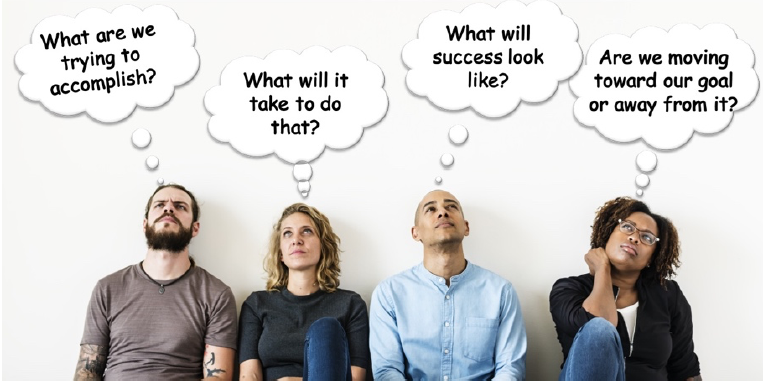Fostering Line of Sight in a group helps to continually connect participants and discussions to shared goals for success.
Line of Sight enables participants to “keep the main thing the main thing” and to have clear touchstones for understanding progress towards goals.
What is Line of Sight?
Line of sight is about strengthening how we think about our ultimate goals and then maintaining an unobstructed vision from our current decisions and actions to those goals. It is about always asking: “What are we trying to accomplish and what would success look like?” Line of Sight is a process, not a product. It’s not the goal itself, it is the goal seeking that supports Emergent Learning. It is a ‘muscle’ that we build by constantly saying, “Let’s remind ourselves what we are trying to accomplish here.”
Line of Sight gives a group a way to keep testing progress against something clear and concrete, which helps a group learn: “Are the decisions we are making and the actions we are taking moving us toward our goal or not?” The process of asking these questions helps us avoid getting lost in the weeds or unintentionally pursuing conflicting goals. Asking these questions helps us avoid conflating strategies and outcomes (e.g., collaboration for collaboration’s sake). They also help us notice if a goal isn’t clear enough or if changing conditions mean the goal needs to shift.

How can we raise our sight?
Line of Sight is not just an intellectual activity, or something that gets done once and then set aside. It should literally be our guiding light – a goal so compelling that it generates the emotional commitment necessary to realize it, no matter what, or how long, it takes. Without a compelling Line of Sight, it is hard to make the case for learning. Why would it matter if you don’t really know where you are going?
Strong line of sight helps a diverse set of people strengthen their connections through a common goal. It paves the way for experiments and innovations across a community. And it grows agency – the next great idea can come from anyone in the system, and often from someone we didn’t expect!
What does this principle look like in practice?
The presence or lack of line of sight in an initiative or project can manifest itself in a number of ways. Here is what we have observed:
- If it’s present: Every person in the group agrees on the goal(s) for each step along the path and would recognize success if they see it. They keep that image in front of them and use it as a guide for making decisions and testing their thinking and results, deepening their understanding of the end state with each success or failure. Everyone is able to see how their work contributes to the whole.
- If it’s missing: People may disagree on what the goals are or think they agree on the goals at an abstract level, but don’t test their fuzzy language. Communication about goals is loaded with add-on ideas and extraneous requirements. People argue endlessly about strategies or get lost in the technical aspects (“the weeds”) of implementation.
How Emergent Learning practices support this principle
The practices of Emergent Learning work together to help strengthen line of sight:
- Action Hypotheses help us make the cause/effect thinking behind our decisions explicit and connect planned actions to a larger goal.
- Emergent Learning Tables help groups gather what they know so far about tackling a goal. As we have pursued our goal so far, what has worked? What has not? The conversation often helps to refine everyone’s understanding of the goal itself, as well as what it will take to get there.
- Before and After Action Reviews start by asking: What are our intended results and what will success look like? AARs ask if we accomplished that and what to learn from it. (Hint: This is why it is not enough to start an AAR with the question “What happened?”).
It’s not always easy at first to define a goal that matters to everyone. But we need to start somewhere, so that we continue to evolve our collective thinking over time. It’s not only the goal itself that matters; it’s the goal seeking that strengthens learning and improves results.
